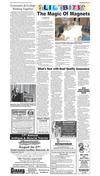5
Broadcaster Press 5
July 14, 2015 www.broadcasteronline.com
$15.7M In Unclaimed Property
PIERRE – State Treasurer Rich Sattgast returned
nearly $16 million in
unclaimed funds this fiscal
year. That figure is up $5.6
million from 2014 when the
state returned $10.1 million
in unclaimed property.
Unclaimed property refers to accounts in financial
institutions, businesses
and government agencies
that have had no activity
for three years or longer.
The State of South Dakota
acts as the custodian of
lost property until it can
be returned to the rightful
owners.
“This last year we
received over 4,000 claims
from South Dakotans,” said
State Treasure Rich Sattgast.
“That’s money getting into
the hands of our citizens
which ultimately makes its
way into our economy and
that’s good for our state.”
Unclaimed Property
is currently holding $69.1
million in unclaimed funds,
but that amount is ever
changing.
“Abandoned and forgotten property is turned over
to the state throughout the
year, so it’s important to
check the unclaimed prop-
erty database regularly,”
Sattgast said. “Our office
participates in numerous
events across the state.
Come visit us at one of the
many fairs we’re attending
this summer and we’ll help
you check for unclaimed
property in your name as
well as assist you in filling
out a claim form.”
To check for unclaimed
property, visit www.
sdtreasurer.gov or call the
unclaimed property hotline
at 1-866-357-2547 to talk
to an Unclaimed Property
representative.
Whether it’s covering
your employees or your family,
we’ve got you under our wing.
To learn more abouT aflac, conTacT:
Coverage is underwritten by
Sierra Whitlock
(605) 760-9844 |
American Family Life Assurance
Z120782B
sierra_musel@us.aflac.com
Company of Columbus.
9/12
Let The
Broadcaster
and Plain Talk
Make Cash
For You!
Early Detection and Action Recommended for
Effective Pinkeye Treatment this Summer
BROOKINGS, S.D. - Warm
weather has many cattle
producers concerned about
pinkeye, the common name
for infectious bovine keratoconjunctivitis (IBK), which
is one of the most common
and economically damaging
cattle diseases.
“Pinkeye is a contagious
disease causing inflammation of the cornea and
conjunctiva. If left untreated,
severe damage to the eye
may occur,” said Janna
Kincheloe, SDSU Extension
Research Associate.
Each year, cattle producers lose an estimated $150
million due to reductions
in weight gain, decreases in
milk production, treatment
costs and potential price discounts for affected animals.
Kincheloe added that the
climate this growing season
is optimal for pinkeye.
“Moist conditions and lush
forage can create optimal
conditions for pinkeye, as
wet weather typically increases the incidence of face
flies that irritate eyes and
help spread the disease,” she
said.
In addition, tall grass
can irritate eyes when cattle
lower their heads to graze.
Prevention is
multi-pronged
Preventing the disease
typically requires a multipronged approach, explained
Russ Daly, Professor, SDSU
Extension Veterinarian.
“The most effective way to
deal with pinkeye is to stay
ahead of it by integrating
prevention with broad-based
treatment strategies developed in conjunction with a
veterinarian as part of a herd
health management plan,”
Daly said.
He explained that an
effective plan often includes
vaccination, fly control and
managing the grazing environment. He also noted that
it takes approximately 4 to
6 weeks to get maximum immune response from vaccine,
so producers should plan
accordingly and vaccinate
prior to observing a disease
outbreak in the herd.
In some cases, veterinarians may recommend using
sterile swabs to take samples from affected eyes in
order to grow the causative
bacteria for an autogenous
vaccine.
“Autogenous pinkeye
vaccines, as well as overthe-counter vaccines, have
not uniformly resulted in
complete protection from
the disease, but may be useful in certain situations,” he
explained.
Daly added that even if
preventative measures are
in place, it is important to
be able to detect and treat
pinkeye early.
Below, Daly and Kincheloe list some signs of early,
active and healing stages of
the disease as well as some
specific treatment recommendations.
Pinkeye Detection &
Treatment
Early stage: Clinical signs
of pinkeye are consistent.
Within the first three to
five days of infection, cattle
blink frequently and have
excessive tearing and there
is redness in the conjunctiva
(white part) of the eye.
“Cattle in this beginning
stage will often seek shade,
typically decreasing the time
they spend grazing,” Daly
explained.
Pain may also contribute
to reduced feed intake. After
a day or two, he explained
that these signs progress to
a small ulcer in the center of
the cornea which appears
as a small white spot. “The
C&R
Construction
•Road Building
•Dirt Hauling
•Gravel Hauling
•Ditching
605.624.6888 or 605.624.2287
COMPETITIVELY PRICED
COVERAGE FOR:
•Homeowners
•Renters
•Farmowners
•Rental Property
Pat Girard
Ph. (605) 267-2421
Mark Donnelly
Ph. (605) 659-5596
FREE YOUTH
ACTIVITY DAY
Broadcaster and Plain Talk private party
classified line ads are now FREE for 30
words or less. If you need more than
30 words, don’t worry you still won’t
pay alot. A 31-word ad is only $.90 and
the cost only goes up $.50 per word
thereafter.
What: Step Outside Program
When: Saturday, July 18th
11AM-3PM
Where: Clay County Sportsman’s
Club - Clay County Park, Timber Road
Who: Youth up to 17 years old.
Must be accompanied by parent or guardian.
(Parental or legal guardian needs to sign waiver form
before youth participates in events.)
Activities: BB Gun Shooting, .22 Caliber Rifle
Shooting, Shotgun Shooting, Archery Shooting,
Trapping Demonstrations
FREE OF CHARGE, please register with
Trevor Job at 605.670.8679
Sponsored by South Dakota Game, Fish & Parks
and Volunteers.
Share the Road
Place your ad by calling the
Broadcaster/Plain Talk office
at 605-624-4429 or by stopping
in at 201 W. Cherry Street today!
L KL
cornea develops a cloudy
blue-grey appearance due to
inflammation. One or both
eyes may be affected, and
the eye(s) are often held
shut due to pain,” he said.
Treat early: The key to
treating pinkeye effectively
is to treat early. “The goal
of early pinkeye detection
and treatment is to eliminate
the causative agent (most
typically Moraxella bovis
bacteria) by using longacting antibiotics, often
tetracycline,” Daly said.
Kincheloe added that
commercially available, nonantibiotic antibacterial topical treatments may also be
effective in helping to alleviate pain and discomfort and
speed the healing process.
“Producers should consult
with their veterinarians to
determine optimal treatment
strategies for individual situations,” she said.
Active Stage: If left
untreated in the early stage
of the disease, the ulcer will
continue to spread across
the cornea, and the eye will
become increasingly cloudy.
“Blood vessels from the
outside of the cornea begin
to grow to help with healing,
which gives the cornea the
classical pink appearance,”
Daly said.
He explained that the
ulcer will eventually cover
most of the cornea and the
inflammation will spread to
the inner parts of the eye.
If this occurs, the inside of
the eye fills with a pus-like
substance called fibrin that
gives the eye a yellow appearance.
Rupture of the eyeball
is rare but may occur with a
severe infection.
Aggressive treatment
is critical
In order to prevent any
further damage, aggressive
treatment with long-acting
antibiotics is critical at this
stage of the disease. Additionally, Daly said there is
some evidence supporting
the use of injectable penicillin in the external layer
of the bulbar conjunctiva
(white of the eyeball). “A
veterinarian should perform
this procedure, as improperly placed injections may
be ineffective and result in
further damage to the eye,”
he said.
Protecting the eye from
sunlight by applying an
eyepatch can also be very
important since ultraviolet
rays can activate enzymes
that can increase eye damage. “This will also reduce
shedding of bacteria,” he
said.
He added that if the animal is in a pasture situation
where keeping the patch on
can be a challenge, construction adhesive can be used
instead of the traditional
eyepatch adhesive. However,
it may be necessary to catch
the animal to remove the
patch. Also, it is more difficult to monitor or administer
additional treatment to eyes
covered with a patch.
Some veterinarians may
prefer to suture the eyelid
shut if the corneal ulcer is
deep and appears likely to
rupture. When treating eyes,
one should wash hands
or change gloves between
affected animals to avoid
spreading the bacteria
further.
Healing Stage: Once the
causative agent is eliminated, the ulcer is quickly
covered by epithelium and
the eye becomes less painful.
Excessive tearing and blinking will subside and blood
vessels will recede, but
Kincheloe said the eye may
continue to be a cloudy blue
color for one to two weeks.
Once this healing occurs,
she explained that the eye
no longer requires antibiotic
treatment. “Clearing of the
edema will begin at the outside edge of the cornea and
sight will begin to return,”
Kincheloe said.
The eyes of most infected cattle heal within 60 days,
but may result in a white
scar that can remain for the
lifetime of the animal.
K
LOOK TWICE, SAVE A LIFE
The Vermillion Police Department reminds
you to be aware of motorcycles and bicycles
who are sharing the road.
Cautious and vigilant driving can prevent a tragedy.











 Previous Page
Previous Page





